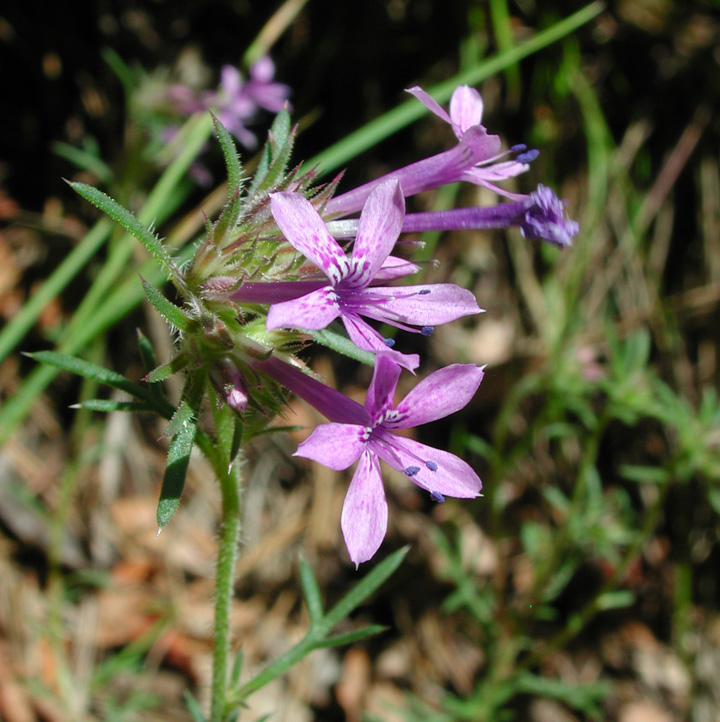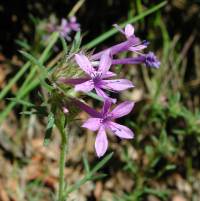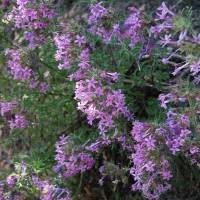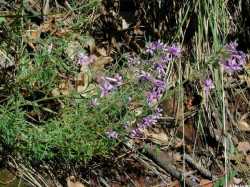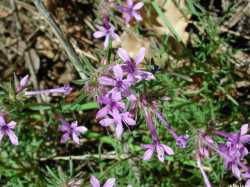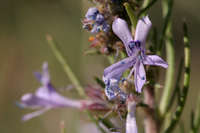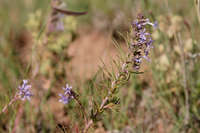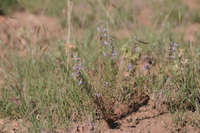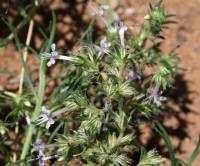PLANT: Short-lived perennial, 15-50 cm tall, simple to branched at base; stems with short to long, glandular to nonglandular hairs.
LEAVES: glabrous to sparsely short pilose or glandular, the lower deeply lobed, the upper entire to few lobed.
INFLORESCENCE: somewhat diffuse to one sided, with subsessile flowers crowded on short, lateral branches.
FLOWER: calyx 4-8 mm long, short-glandular pubescent, the lobes short aristate; corolla pale violet to purplish, the tube 5- 15 mm long, the throat 1-2.5 mm wide, the lobes subequal, the lower 3 partly united, often with purple flecks; stamens inserted on the upper tube or throat; filaments unequal; anthers exserted; stigma slightly exceeding the anthers.
CAPSULE: 4.5-7 mm long; seeds 2-8 per locule.
NOTES: Open sites, desert shrublands, woodlands; Apache, Cochise, Coconino, Gila, Graham, Maricopa, Mohave, Navajo, Pima, Pinal, Santa Cruz, Yavapai cos.; 670-2590 m (2200-8500 ft); Jul-Oct; s CO, NM, TX, and n Mex. Plants with short corolla tubes (5-8 mm long) included in the calyx have been called Gilia polyantha Rydberg var. whitingii Kearney and Peebles, which may represent a distinct species. Typical I. polyantha (Rydberg) V. E. Grant, endemic to s CO, differs by its taller (40-70 cm), often solitary stems, uniformly glandular pubescence, glabrous to sparsely pubescent calyx lobes, and white corollas with equal lobes.
REFERENCES: Dieter H. Wilken and J. Mark Porter, 2005, Vascular Plants of Arizona: Polemoniaceae. CANOTIA 1: 1-37.
Duration: Perennial
Nativity: Native
Lifeform: Subshrub
General: Short-lived perennial herb, 15-50 cm tall; stems unbranched or branched at the base, with short to long, glandular to non-glandular hairs.
Leaves: Alternate along the stems; blades simple and linear (upper) or pinnately dissected into 3-5 linear lobes (lower), glabrous to sparsely short pilose or glandular.
Flowers: Showy and purple, in leafy, diffuse terminal panicles, these often one-sided, with subsessile flowers on short, lateral branches; calyx consisting of 5 glandular-pubescent, awn-tipped sepals, 4-8 mm long, connected to each other by papery membranes; corolla rotate to salverform and 5-lobed, pale violet to purplish, the corolla tube 5-15 mm long and the throat 1-2.5 mm wide, corolla lobes subequal, the lower 3 partly united, often with purple flecks; anthers and stigma exserted beyond corolla.
Fruits: Capsule 4-7 mm long, with 2-8 seeds per locule.
Ecology: Found in open sites from desert shrublands up into woodlands and in montane forests, from 2,000-8,500 ft (610-2591 m); flowers July-October.
Distribution: s CO, AZ, NM; south to n MEX
Notes: Often distinguished by its open, diffuse habit, with many little purple flowers.
Ethnobotany: Powdered and applied to the face to treat headaches; applied to wounds; and the blossoms were smoked as a pulmonary aid. Also used ceremonially by the Ramah Navajo.
Etymology: Ipomopsis means like Ipomoea, the morning glory genus; multiflora means many-flowered.
Synonyms: Gilia multiflora
Editor: SBuckley 2010, AHazelton 2017


